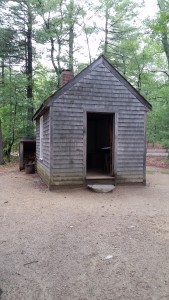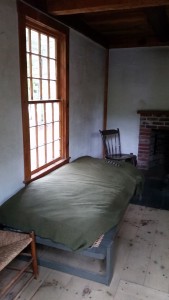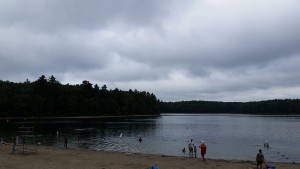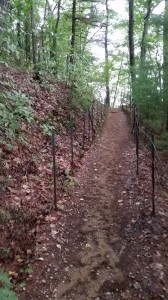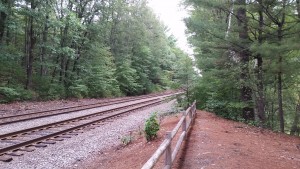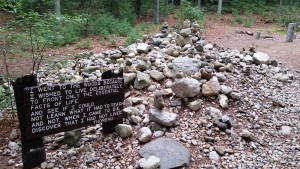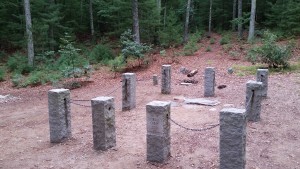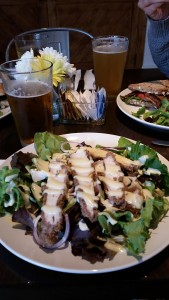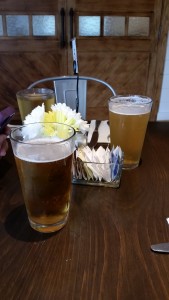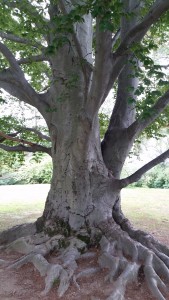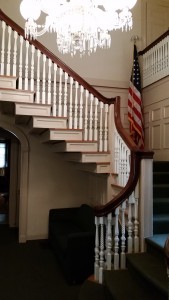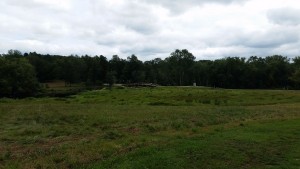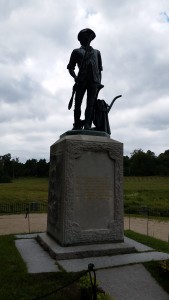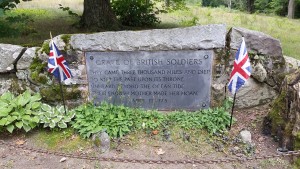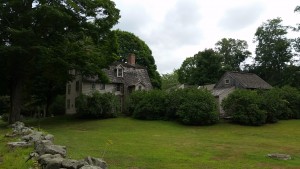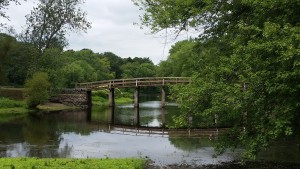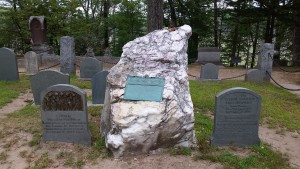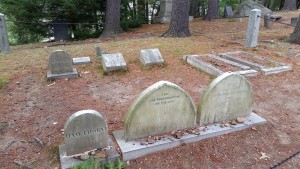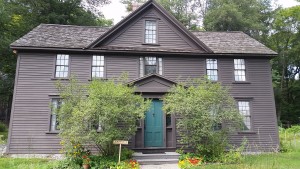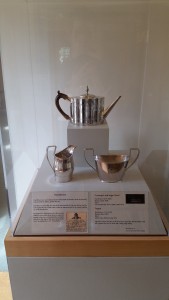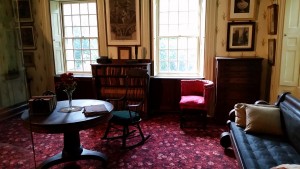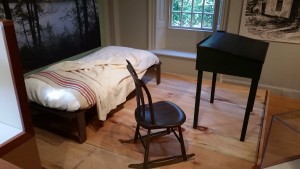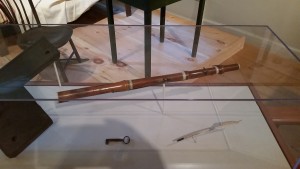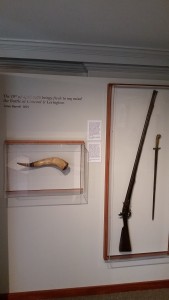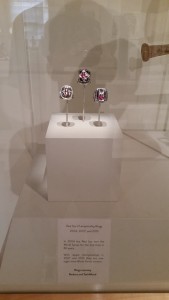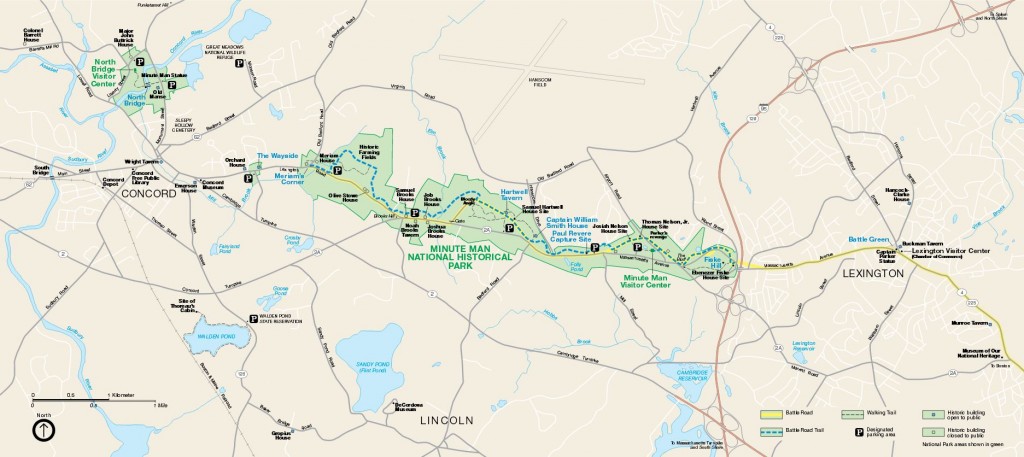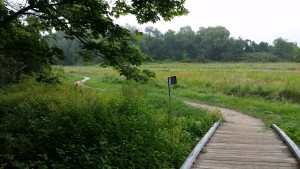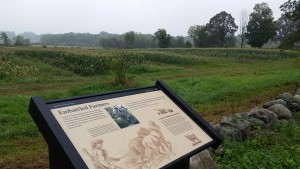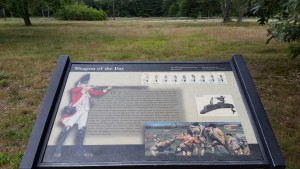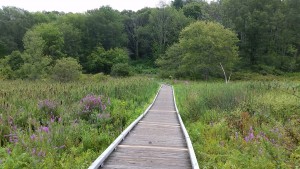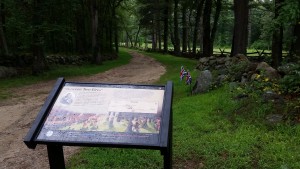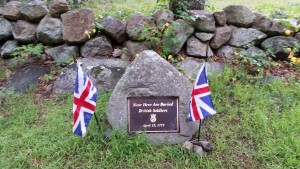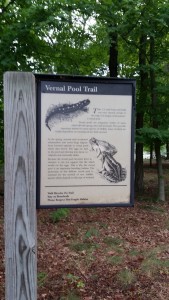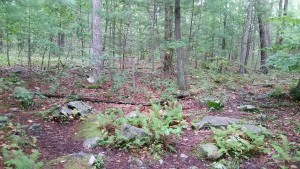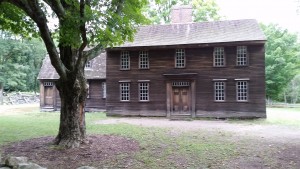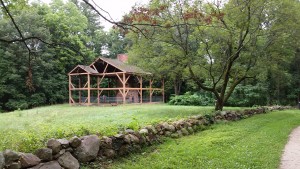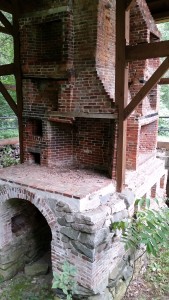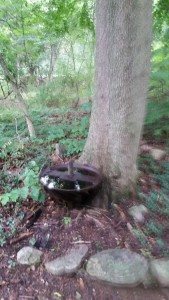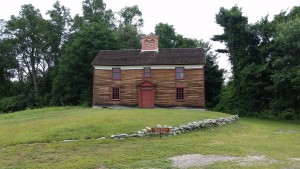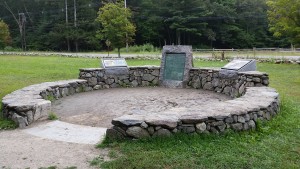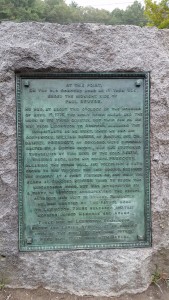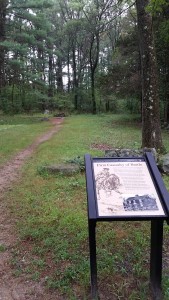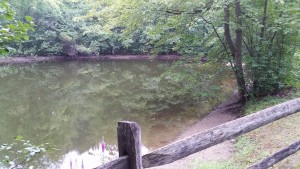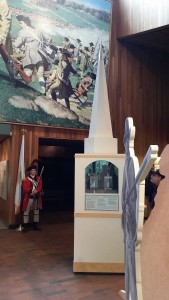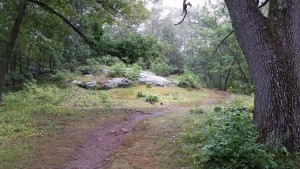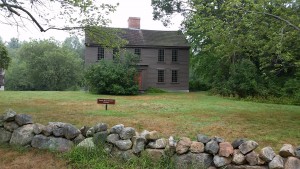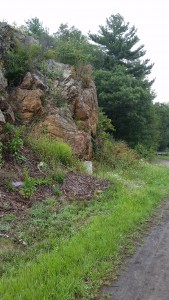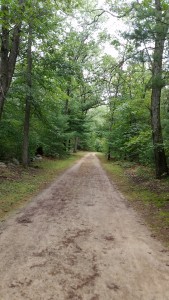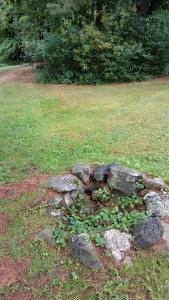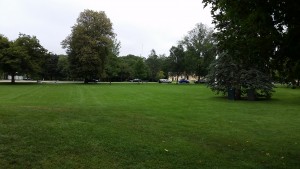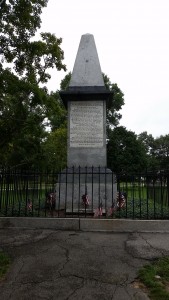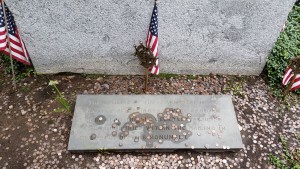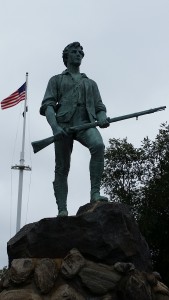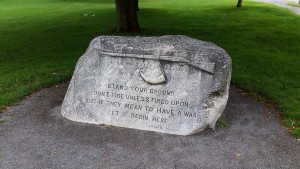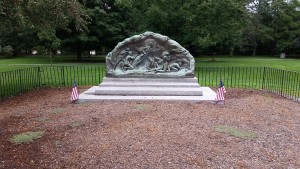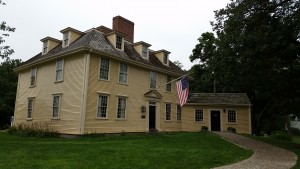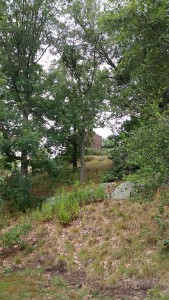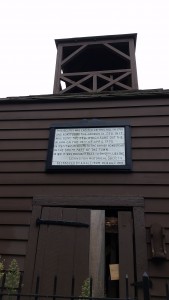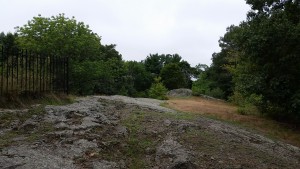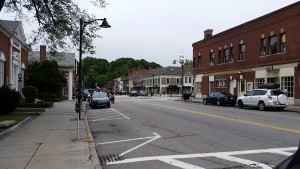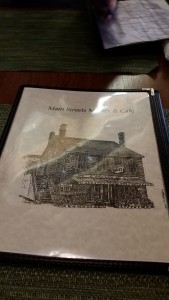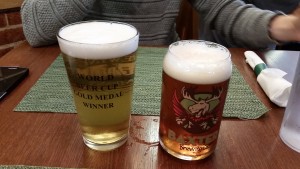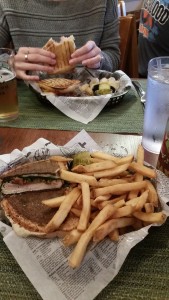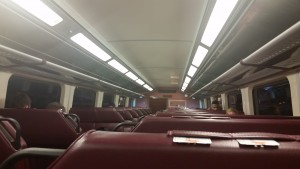[FYI: It’s pronounced “Con-kerd” not “Con-cord”]
Shortly after SB and I moved to Boston we started coming up with a rather lengthy to-do list. Most of the list involves historical adventures in and around Boston since it’s kind of a hard city to beat when it comes to US history. Other items on the list include other areas such as Salem, Cape Cod, and of course, Lexington and Concord. In fact, I’d argue that it would be patently un-American to live in Boston and not make it out to see Lexington and Concord, so those were two things that were quickly placed on the list, and surely enough, one year later we made it out to visit.
Concord itself is only about 20 miles from Boston (Lexington is closer), so it’s not a huge distance. The problem is that SB and I have no car and while Concord does have a commuter rail station, its closed on weekends due to ongoing construction. Further, there is no public transportation between Lexington and Concord. So to get between the two of them with no car you either need to walk (~7 miles) or take public transportation all the way back to Boston, and then back out again. So when we began researching this trip we determined pretty quickly that we’d need a car. Sadly, like everything else out here, rental cars are expensive. Then, on top of it all we’d need to pay to stay a night in a hotel (or a B&B) since even if we wanted to drive home, we have no place to park. So what was supposed to be just a little mini-vacation kept getting more and more expensive.
Enter Aunt Train.
Aunt Train lives in Lowell, which is only about 16 miles away from Concord. Further, Aunt train has a nice new car. Aunt Train also likes traveling, so we invited her to come on our adventure. She wasn’t that interested in Lexington, but wanted to see Concord, so we decided we’d go to Concord together on Saturday, then SB and I would go to Lexington on Sunday. Not only would we still be able to see everything, we’d save hundreds of dollars on the rental car and lodging and we’d get to see Aunt Train. Wins all around.
As the weekend grew closer, the weather forecast just kept getting worse and worse, to the point that we seriously considered rescheduling the entire trip (which would not have been easy). However, despite the meteorologists’ forecast of gloom and doom, it was a mostly dry weekend, even if it was fairly cloudy with some occasional misting.
So on Friday night we packed up and headed up to Lowell via the train – this was also a chance for me to return the suitcase that Aunt Train had let me borrow for Denver. It started pouring right as we were getting to Lowell, and since it is about a 15 minute walk to Aunt Train’s apartment we were pretty concerned, luckily we waited at the station for a few minutes and then the rain almost entirely stopped. That night we had some pizza and drinks and visited with Aunt Train before heading to bed. The next morning we got up and around and headed off to Concord!
The first stop was Walden Pond, which is where Henry David Thoreau lived for two years while writing Walden. In fact they even have a replica of his cabin, which was based on Thoreau’s own detailed notes.
Even the interior is designed based on Thoreau’s items and his descriptions.
Interestingly enough, Thoreau described having parties of 25-30 people in that small cabin. Yeah, no thanks.
The replica cabin is actually about half a mile away from where his original cabin once stood, so we had to walk across a road and down a hill to actually get to Walden Pond itself.
Like most things, civilization has come to Walden Pond, and it is now home to a sizable beach and lots of swimmers. That said, really only one corner of the pond is especially busy. You can take a 1.7 mile trail around the pond to get a bit more secluded. But don’t plan on doing too much exploring.
Pretty much the entire trail is surrounded by fences on both sides. We were really wondering why they did that, but we later learned that the entire pond is in the middle of a shoreline restoration project, so it’s to keep people from trudging all over things, as people often do.
The trail is fairly easy though, and it does take you to the more remote areas of the pond.
But not too remote, as there are some railroad tracks nearby, which were there even when Thoreau was living by the pond (plus his cabin was only about 30 minutes from his parents’ house).
Eventually the trail takes you to the original cabin location, where there is a make-shift rock pile memorial. I placed a rock on it of course, I believe Aunt Train took a photo.
The outline of the actual cabin is made via posts and chains.
Apparently the location was lost for some time, until it was “discovered” by a member of the Thoreau appreciation society, pretty cool.
But we weren’t, it wasn’t hot, but it was very humid. So after our Walden hike, it was off for some yummy lunch.
Of course yummy lunch also means yummy beers (and a cider, for Aunt Train). 🙂
We figured we’d earned them with all that walking.
Next up we decided to head into the western portion of the Minute Man National Historical Park, namely to see the Old North Bridge. I was extremely excited, to put it mildly.
When we got to the Visitor’s Center the area was surrounded by a ton of old growth trees that were there to see the dawn of the American Revolution.
Of course more than a few of them had been carved up, but that sadly tends to happen over the course of hundreds of years. The visitor center was pretty cool on the inside as it was a period building.
The center was was actually the former home of Major John Buttrick (a Concord Militia Captain during the North Bridge skirmish).
After walking around the grounds of the center we laid eyes upon the North Bridge itself.
To be honest I actually got tinglies all over.
Once we got closer (you come up on the “American” side) I was able to check out the Minute Man statue.
This 1875 Memorial, aptly titled Minute Man, was done by Daniel Chester French (the same sculptor who did the Lincoln Monument in Washington DC, as well as the monument of a guy you may or may not have heard of named John Harvard – and who is buried nearby in the Sleepy Hollow Cemetery, but more on that in moment). On the statue’s base is an inscription from the “Concord Hymn” by Ralph Waldo Emerson. While the name might not be familiar to you, I can practically guarantee that you know at least part of this hymn. See for yourself:
By the rude bridge that arched the flood,
Their flag to April’s breeze unfurled,
Here once the embattled farmers stood,
And fired the shot heard round the world.
Told you.
Well, it turns out that we aren’t exactly sure who fired the first shot at the North Bridge. What is certain though, is that these were not the first shots fired on April 19th, 1775, but we’ll get to that in a bit. What we do know is that this was first time the Colonists fired a deadly volley at the British, so the North Bridge was the first site with losses on both sides. So while there is no definitive “shot” heard round the world, metaphorically it works for the North Bridge since that was the first spot where a British Solider was killed and therefore the full treason had begun.
This marker on the “British” side of the bridge marks the spot where the Colonists buried the British soldiers killed at the North Bridge.
Also on the “British” side of the bridge is the older 1836 obelisk memorial.
Its inscription reads:
“On the 19 of April, 1775 was made the first forcible resistance to British aggression. On the opposite Bank stood the American Militia. Here stood the Invading Army an on this spot the first of the Enemy fell in the War of that Revolution which gave Independence to these United States.”
Nearby is the “Old Manse” which was historically owned by the Emerson family and whose occupants had a front row seat to the skirmish at the North Bridge.
The old dock down below the Old Manse had an awesome view of the North Bridge, and I was lucky and patient enough to get a photo with no people in it.
After our time at the North Bridge, we headed over to the Sleepy Hollow Cemetery. Since I know you are wondering, no, this is not the Sleepy Hollow that inspired “The Legend of Sleepy Hollow” by Washington Irving. That Sleepy Hollow is actually a secluded glen north of Tarrytown, New York. This Sleepy Hollow is a cemetery, and an old and big one at that.
It’s not often that you get to visit a cemetery with Veterans from every war since the American Revolution. However, Sleepy Hollow is probably most famous for its “Author’s Ridge” which is the final resting place of Louisa May Alcott, Ralph Waldo Emerson, Henry David Thoreau, Nathaniel Hawthorne, and others (Concord was home to many great American authors).
It took us a bit to find the graves, but we persevered.
Emerson:
Hawthorne:
Alcott (She was a nurse in the Civil War, if you were wondering about the Veteran status)
Thoreau (a larger Thoreau family marker was next to his smaller grave):
In one of those rare “SB is Smarter than Me” moments, it took me an embarrassingly long amount of time to release why people were leaving pens on the graves.
After departing from the departed, we went and checked out the Orchard House, which is where Louisa May Alcott grew up and also where she based her novel Little Women.
Very nearby was Emerson’s home.
Just down the street from Emerson’s house was the Concord Museum.
SB and Aunt Train weren’t super interested, but I was, so I left them in the lobby and went and did some museum exploring.
They had some silver items that had been made by Paul Revere himself, who, if you weren’t aware, was a silversmith when he wasn’t doing the whole Sons of Liberty thing.
Even more cool (and what brought me to the museum in the first place) was the actual lantern that was used as signal to start Paul Revere’s ride.
I could not understand how SB and Aunt Train didn’t want to see it, their loss.
They also had the furniture and books that Emerson had adorned his private study with.
Emerson wasn’t the only one with some writing memorabilia in the museum though, they had somehow got the actual items from Thoreau’s Walden Cabin.
This included his personal flute, still engraved with his and his brother’s initials.
Given that Concord is most famous for being where the sun rose on the American Revolution, there was plenty of items from the battle as well. Most prominently, in my opinion, was the actual musket and powder horn used during the battle by Amos Barrett, a Colonial Militiaman.
Of course it wasn’t all old stuff, not that I mind. They also had a baseball section, which included 3 of the most recent Red Sox World Series Championship Rings.
After that we began our trip back home. Aunt Train took us out for some yummy Indian Food and then we chilled for the rest of the night. The next day SB and I were up early again and this time we were off to the Battle Road Trail, which follows the path of the British retreat from the North Bridge all the way back to Lexington during the Battles of Lexington and Concord. We actually started in Concord and worked our way towards Lexington, following the path of British retreat. The park map actually suggests that you walk the opposite direction, but that is because the Minute Man Visitor Center is near the Lexington end of the trail. Naturally, I ignored that advice because I wanted to follow the historical direction. Of course the British actually went both directions. Which brings us to the point where I need to give a bit of a history lesson.
Stop groaning and pay attention. You’ll learn something, I know I did.
So for most Americans the Battles of Lexington and Concord bring to mind the fighting at the North Bridge and the ride of Paul Revere, with the later largely being recognized because of the poem “Paul Revere’s Ride” by Henry Wadsworth Longfellow.
Listen, my children, and you shall hear
Of the midnight ride of Paul Revere,
On the eighteenth of April, in Seventy-Five:
Hardly a man is now alive
Who remembers that famous day and year.
And so on and so forth. You probably never even heard the poem beyond the introduction, I know I didn’t.
The thing is, while April 19th, 1775 is an incredibly important date in US history, things didn’t quite unfold the way I remember them being taught. Of course, as a Historian, I’ve long since learned that history is rarely in line with popular memory. That is not to say that history is never as interesting or fantastical, just that what you are told from mass education is rarely the entire story, or even mostly correct. But that, dear friend, is why Taco is here. I do the research so you don’t have to.
So, let’s lay things out a bit. First off, here is a picture of a picture showing the Minute Man Park, which roughly follows the battle path.
And since that probably doesn’t show up too well, here is a closer image of the Battle Road Trail.
You can click it to make it even bigger.
But really why I’m sharing those isn’t to give you a super detailed overview, though you can easily find those via Google. It’s simply to orient you on where things generally happened. The following map is even more zoomed out, which gives you a general idea of troop movements.
So, now that you have general idea of geography, here is an overview of what happened during the Battles of Lexington and Concord, in Taco prose.
Our story actually begins on April 18th 1775 (or much further back, if you really want to get into the nitty-gritty of it), rather than on April 19th. Around 5:00 pm the British, who were in control of Boston, sent out patrols into the countryside to block any messengers the militia might be using. You see, the British knew that the militia had been stockpiling arms and ammo and cannons in Concord, so they were going to send out the “Regulars” (e.g. the Redcoats you probably just envisioned in your head) to destroy and/or claim those supplies. However, colonial spies knew of the plan and most of the supplies, including most of the cannons, had been removed from Concord (and likewise British spies knew this, but they still thought there was more left in Concord than there actually was). So, the British wanted to stop any messengers from sending out warnings when the troops began to march out of Boston for Concord.
Seeing that the troops were indeed preparing to march, Paul Revere and William Dawes left Boston via a small boat under cover of darkness around 11:00pm that evening. This is where the infamous “One if by land, two if by sea” lantern signal from the Old North Church came into play. What most people don’t know, is what this actually means. First, the line is from Longfellow’s poem. That said, at least one lantern (seen above) was used to signal from the church, and the purpose was to show the patriots whether or not the British were marching across the land bridge, or moving via boats across the Charles River (remember Boston was practically an island back then, see the image above). Also, Paul Revere himself didn’t give the signal via the lanterns, as this would make no sense. Rather, the lantern(s) was lit by other patriots to signal to Paul Revere (and others) that the British were moving and how they were moving. Somewhere in history people got confused about this, but no, Paul Revere didn’t send a signal to himself, it would make no sense. Oddly enough, we actually have no idea just who did send the signal that evening around 11:00pm, other than that we think there were three of them, but we do know that there was a signal and it was via lantern from the Old North Church.
Also, you’ll notice I mentioned more than just Paul Revere. Yes, this I definitely didn’t learn. Paul Revere wasn’t alone, he was accompanied by William Dawes, a tanner and a member of Boston’s militia. Additionally, other riders headed off in different directions to rouse other militia. Revere just became the most famous. Further, Revere and Dawes weren’t even the first ones to head for Lexington that night, there was an earlier “unknown” patriot rider who was captured en-route to Lexington and whose name has been lost to history.
Around 12:30 AM on April 19th, Revere and Dawes arrive in Lexington and alert the militia sentries that the “Regulars are coming” and the bells begin ringing in the Old Belfry. Revere and Dawes then set off again, however they’ve been joined by Samuel Prescott, a Doctor from Lexington. The three of them continue onward to Concord.
Around 1:30 AM the British patrols catch sight of Revere, Dawes, and Prescott. When the patrol attempts to capture them, Prescott darts over a fence. Being from the area he knows it well enough to evade capture and sneak off into the night where he continues on to warn Concord. Dawes also evades capture, but is forced to retreat back to Lexington as he isn’t familiar enough to leave the road. Revere, being the forward rider, is actually captured by the British patrol.
Yep. Paul Revere was captured. I certainly didn’t know that when I was younger.
However, things didn’t go so bad for him, aside from being caught that is. The patrol probably didn’t know who he was, so they marched him back to Lexington, took his horse and supplies, and then let him go. He promptly returned to the other Sons of Liberty and continued plotting the British downfall, bad move on the part of that patrol.
Soon after Prescott arrives in Concord, where he alerts Major John Buttrick. The militia then gathers at Wright’s Tavern and other messengers go out into the countryside to gather more militia who begin to trickle in during the rest of the night.
Around 2:00 AM the British Regulars, numbering at about 700, begin their march towards Concord after crossing the Charles River.
Around 2:30 AM, the previously captured Revere is released in Lexington, and bells and alert guns begin to warn the Lexington militia gathered at Buckman’s Tavern of the British advance.
By 4:30 AM the British column is only about a half-mile from Lexington, Captain John Parker of the Lexington militia has his men gather on the Lexington Green where he says one of the most bad-ass things ever: “Stand your ground. Don’t fire unless fired upon, but if they mean to have a war, let it begin here.”
Around 5:00 AM the Colonial and British forces meet at the Lexington Green. There were 77 militiamen and around 700 Redcoats, not exactly a toe-to-toe standoff. Now here is where things get murky. Someone fired their gun. We still have no real idea who it was. What we know is that both sides had been ordered not to fire, the militia by Parker and the Regulars by John Pitcairn, one of the three leading British officers for the Concord expedition. However, someone fired first. Some claim it was a colonial citizen, who shot from within the tavern and who wasn’t actually in the militia, others blame the nervous militiamen themselves, and many of course blame the British. We’ll probably never know for sure, but once that first shot was fired, things broke down pretty quick. In response to the shot, the British sent out a volley of fire. The Lexington Militia sporadically returned fire, but they largely broke apart under the hailstorm of British shots. In the end 8 militia are killed, 9 are wounded, with some of the dead having been bayoneted by the British troops as they advance. One Regular is wounded, though none are killed. The militia retreats, and the British continue their march to Concord.
Around 7:00 AM the first group of British, lead by Francis Smith (second of the three officers), arrive in Concord. They begin searching the town for supplies, finding most of what was still present, including three cannons. While the search is ongoing they dispatch a group of about 115 soldiers to guard the North Bridge while the supplies are destroyed. By this point the militia, amounting to about 400 men at the point, where mustering on a hill across the river. When they saw the smoke from the supply fires they thought the British were burning Concord, which obviously pissed them off, so they began to advance. A standoff occurs at the North Bridge.
Around 9:00 AM the last brigade of British Regulars, under Hugh Percy (the third officer), leave Boston for Concord – about 5 hours behind due to delays.
Around 9:30 AM the shot heard round the world is fired, followed by full volleys being fired, resulting in losses by both sides, the first British regulars have been killed. The outnumbered British send for reinforcements, but the growing militia surges forward, forcing the British to abandon their dead and wounded. During this time the militia reportedly scalps one or more of the wounded or dead Regulars with their hatchets and knives, causing outrage among the British.
By 12:00 PM Pitcairn and Parker realize that Percy’s reinforcements are too far away and order a retreat from Concord. The militia forces continue to grow as men pour in from the countryside.
Around 12:30 PM the long march back to Boston begins. The British Regulars have marched and fought all night long, haven’t slept, and are low on supplies. The militia follows the retreating British and each side fires as the battle progresses back towards Lexington. The first running exchange of fire occurs at Meriam’s Corner, a branch in the road east of Concord and just south of the Meriam family homestead.
By 1:30 PM the militia has amassed to around 1400 men and the British column is under almost constant fire. At one point, called the “Bloody Angle” the British are fired on from both sides as they traverse a sharp turn in the road. Later, Parker and his reformed Lexington militia ambush the column from a rocky hill, this skirmish is later called “Parker’s Revenge” as payment for the 8 killed earlier at the Lexington Green.
Around 2:30 PM the militia launch a large scale ambush at Fiske Hill, here Colonel Smith is shot from his horse but survives.
Around 3:00 PM Pitcairn and Smith’s forces meet Percy’s reinforcements of 900 about a half mile east of Lexington. Percy has marched with artillery which is then used to break up the swarms of militia following the column. However, Percy’s troops had to leave Boston in haste and are low on supplies from the very beginning (reportedly each Regular only had about 36 pieces of ammunition).
Around 3:30 PM the combined British forces resume their withdrawal to Boston, burning houses as a way of drawing out snipers and forcing disorder among the militia.
By 4:30 PM the British reach Menotomy (present day Arlington), this is where the bloodiest fighting of the battles occur. With militia and Regulars engaging in bayonet and close-quarter combat. The fighting spreads through houses and streets. Neither side gives the other any quarter during the bloodiest phases of the battle.
Around 6:00 PM the column reaches Cambridge where the fighting continues, some of the fighting reaches Harvard College and the older buildings on campus still bear signs of the combat.
By 7:00 PM the British column reaches the safety of the fortified Charlestown, where the militia are in range of both the artillery and the ships in the harbor, forcing them to draw back. Both sides dig in and the 11 month Siege of Boston begins, the Revolutionary War has begun.
By the end of the day around 3,960 militiamen had joined the fight and the British column had grown to around 1,500 soldiers. The British had 73 killed, 174 wounded, and 53 missing. The Colonials had 49 killed, 39 wounded, and 5 missing by sunset on April 19th.
And that, dear friends, is the nutshell version of how the Battles of Lexington and Concord unfolded. The reason I wanted to share that, is because it will make the rest of this post make a lot more sense.
Since it was so well documented and much of the original road still exists, the modern Battle Road Trail is able to track to the same path as the British took both to and from Concord. SB and I started our walk on the east end of the trail, out near Meriam’s Corner. We parked Aunt Train’s car in a little side parking lot and were on our way.
Along the route there are several information posts that tell you either about that specific point, or about the area and time of the battles in general.
There were some gorgeous wetlands along the trail.
Some of these wetlands had to be marched through in 1775, but most of them were dry as they were ditched and drained for wheat fields and farmland (though some were still wet, as apparently they also harvested “wetland wheat”). Now that the area is protected the wetlands have obviously returned to their natural state.
Most of the area is just as it was 240 years ago, including the stone walls that the Colonists would have used as cover.
Just beyond the remnants of Brooks village is the infamous “Bloody Angle” I mentioned above, where the British column came “Between Two Fires” (as recorded by a British officer).
As the British were in withdraw, many of their dead were left behind. The colonial militia and/or local farmers were either ordered or felt compelled (as good Christians) to bury the fallen Redcoats. So while the exact location of many of the graves has been forgotten to time, the general areas are marked along the path with these markers, complete with the Union Jack as it appeared in 1775.
Just past the Bloody Angle SB and I became intrigued by a lesser-traveled side path that lead to a Vernal Pool.
Mainly we were just drawn in by the promise of animal friends. The trail was definitely a bit more rough and tumble than the Battle Road Trail was.
As you can see, the trail was ehm.. a bit not there at times. But we made it. Sadly the Vernal Pool was pretty much a letdown as it wasn’t currently full, despite all the rain. Instead we found an isolated wooden platform and nothing more.
Luckily the hike on the side trail was pretty cool, SB and I even pee’d in the woods like real outdoorsy types.
Once we reunited with the Battle Road Trail it wasn’t long before we came across the Hartwell Tavern, which set just back from the road as the battle raged by. It is one of the so-called, “witness” houses, which are those houses that essentially became part of the conflict due to the armies crossing paths with the building.
A stone’s throw from the tavern is the site of Samuel Hartwell house, which was where the owner of the tavern lived and the buildings combined make up the larger Hartwell Homestead.
I say site because the house itself has pretty much been reduced to the foundation and the huge chimney structure. The exterior structure has been built as an “outline” of the original home, but it also serves to hold up original chimney. Speaking of the chimney, it was huge, and amazing.
It was really cool getting to see the entirety of an old chimney for a big house like this would have been, from the kitchen to the various floors you could imagine it all based on the chimney itself.
Just behind the house was a little trail with some sort of object on it, I have no idea what it is. It was filled with rainwater, was punched into the ground on a pole, and the bottom of it almost looked like a big auger or something. Sadly the picture came out blurry, but I figured someone (such as my Dad) might know what it is.
From there we got into some more open stretches of road, where the British column found itself flanked again and again.
The road also passes by the witness house of Captain William Smith.
This house had kind of a cool story. As the British column was retreating past the house, a Regular was shot and severely wounded. Unable to carry him, his fellow soldiers left him behind as the militiamen closed in. The Smith family took the soldier in and tended to his wounds for two days before he died. Fearing that he had gravely inconvenienced the Smith (medical supplies would have been running low) the dying soldier told them that he had a solid gold coin sewn into his uniform as a way of repaying their kindness before he died.
Before too much longer we made it to the site where Paul Revere and his cohort were intercepted and Revere was captured.
The center memorial is obviously much older than the adjacent information signs.
Past this point the route gets a bit more wooded again before it crosses near the site of Josiah Nelson’s house.
Josiah Nelson is unofficially referred to as the first casualty of the American Revolution. I say unofficially because the story that follows has never been confirmed. However, the tale goes that early in the morning of April 19th, even before the 5:00 AM skirmish at the Lexington Green, Josiah Nelson noticed a group of men walking down the road. Knowing that the British were advancing due to the prior warnings, he ran from his house to ask the men where the British were at, as he was responsible for warning the militia of the town of Bedford when the British were near. Unfortunately for Nelson, the darkness had concealed the fact that the group of men was actually a British patrol, the same which had captured Revere hours earlier. Upon realizing this, Nelson went to turn and return to his home when one of the British soldiers struck him across the head with a sword. Content that Nelson would be of no further trouble, the patrol then continued on its way.
Nelson, however, recovered from the blow and his wife Elizabeth bandaged his wound. He then mounted his horse and rode for Bedford where he alerted the militia as instructed. While this is a cool story, there is unfortunately no way of really verifying it, as it is mostly based on a family tradition. That said, if you were going to make up a story it seems like you’d paint yourself as a bit more valiant than getting clobbered with a sword due to mistaking the enemy. Either way, the British column would eventually make its way past Nelson’s house later in the day on the 19th.
Near here is also where the Minute Man Visitor Center is located, which has a nice little pond near it.
The Redcoats appear to have reclaimed this particular spot sometime over the past 240 years.
However, they did sell us National Park animal crackers, so they’re good in my book.
Once we got back on the trail, we passed the rocky hill which was were “Parker’s Revenge” occurred.
As the fighting was especially intense at this point, with the British in withdraw and Parker trying to avenge his fallen militiamen, its no stretch to say the air was heavy. There were losses on both sides on this small hill, and SB was almost a causality herself as a big branch fell out of a tree near us. It was kind of eerie.
A bit further down the road was the Jacob Whittemore house, another witness house to the battle.
A bit beyond that was a large rocky cliff face that was a bit unlike any of the surrounding terrain.
It was here that the British temporarily rallied, pushed back the militia, and reorganized their column. Of course the slowed pace also meant that more militia caught up to the fighting, so soon the British were overwhelmed and retreating once more.
At this point the road is nearing Fiske hill, but there was one more stretch where a Colonial sniper crept up to the British column, killed two soldiers from behind a boulder, and then managed to somehow escape with his life.
As mentioned, Fiske hill is also where Colonel Smith was shot from his horse and wounded. Also at Fiske hill is an original well, which was the spot where a militiaman and a Regular shot each other and then engaged in hand to hand combat to the death. Both died right next to this well, which is now grated but still functional.
Fiske Hill marks the end of the official Battle Road Trail, though the Regulars obviously continued through Lexington and all the way back to Boston. For our purposes though, we were only going to Lexington, which was actually still about 1.6 miles further from the end of the trail. Our destination was the Lexington Battle Green.
The Lexington Battle green is home to the oldest war memorial in the United States, the Revolutionary Monument, erected in 1799.
It marks the spot where the 8 militiamen who died in the early morning fighting on the green – the first American deaths of the war – are buried.
I of course paid my respects with a penny, and it even stayed on the plaque, I like to think of that as a good sign.
Near this memorial is the much newer (comparatively speaking) minuteman statute, which was erected in 1900 and is believed to be a representation of Captain John Parker himself, though that isn’t confirmed.
Just a bit down from the minuteman statute is another monument, memorializing Parker’s famous quote.
And across the street is the Lexington Minutemen Relief.
Just up from the relief is Buckman Tavern, which, as mentioned, is where the militia gathered prior to the British arrival. The tavern now serves as the Lexington Visitor’s Center.
And while the original belfry that sounded the alarm and that stood on the green itself has long since been removed, there is a replica on a nearby hill located in Belfry Park.
SB and I, being the geniuses that we are, didn’t notice the path from the main road and ended up scaling that hill like special operatives, very fat and slow special operatives, but special operatives nonetheless.
According to the sign, this is the original belfry, which was just moved several times (aside from the minor detail of it being destroyed by a gale in 1909). That said, between you and me, I have my extreme doubts that this is the original belfry. Sure, I bet it has pieces of the original, but I doubt they moved it around piece for piece that many times. Still cool though.
The hill where the belfry was relocated reminded me a lot of the many outcroppings SB and I explored in Salem.
After descending from the Old Belfry we caught an Uber all the way back to Concord (SB used a coupon to get the ride for free, score), because there was “No way in hell” we were walking that far back. While the rain had been cooperative and mainly stayed at a mist, that was a long way off. So we Ubered back to Aunt Train’s car and then drove into downtown Concord for some lunch and much needed beers (being the sleepy little New England towns they are, surprisingly little is open on Sunday in Lexington and Concord).
We picked the Main Streets Market & Cafe, which was aptly named given its location.
Beers were quick to follow, SB really liked my beer glass (on the right) and wanted to buy it, but I was the scrooge and said no (in my defense we have no space and just got rid of glasses for that very reason).
Soon enough the food arrived and complimented our beers and a long day of hiking quite well. 🙂
After that we drove back up to Aunt Train’s apartment in Lowell. We had just missed the 5pm train, so we waited for the 7pm one which meant we got to visit a bit more with Aunt Train, which was nice. But soon enough it was time to head back to Boston.
It was a very sleepy ride, but much less crowded than when we had came up on Friday. Once we got home we chilled for a bit and then got some much needed sleep.
All in all, we walked just over 19 miles on Sunday alone. Granted, we weren’t being shot at or being required to shoot people, but it was still a long hike. While there is a well reviewed (but very expensive, 28$ per adult) shuttle that runs between the towns and stops at some of the more major locations, I would highly, highly recommend doing the walk. Not only does the shuttle miss the vast majority of sites (which simply aren’t accessible via a shuttle), but you don’t have much time at each spot. Further, by walking through the dirt and the trees and clamoring over stones and up hills you get a better experience of what it might have been like on the days of April 18th and 19th, the days that quite literally saw the Revolution begin.
I can only imagine how both sides felt, after fighting for hours on end with no sleep, with nothing but the fervor of battle carrying you along. This especially true for the Regulars, who in total had marched 40 miles, hadn’t slept for two days, and were constantly under fire. In fact, even once they reached the safety of Charlestown it took an additional three hours to ferry the wounded troops across the river to Boston.
Seeing this two towns was a pretty extraordinary experience. While I do rag on Murka’ from time to time (which as a native-born Murkan’ is my right to do), I also believe that it is by far the greatest nation on Earth. As such, it was pretty awesome to walk in the footsteps of both armies on those fateful days in April of 1775 that ultimately led to the birth of the United States of America and proved that we had what it would take to stand toe-to-toe with arguably one of the most powerful Empires in the world at the time.
I love that living out here has enabled me to have so many amazing chances to experience history that many people have never had.
And, as always, I hope you’ve enjoyed reading about my adventure and maybe even learned something along the way. 🙂
Until next time,
-Taco
